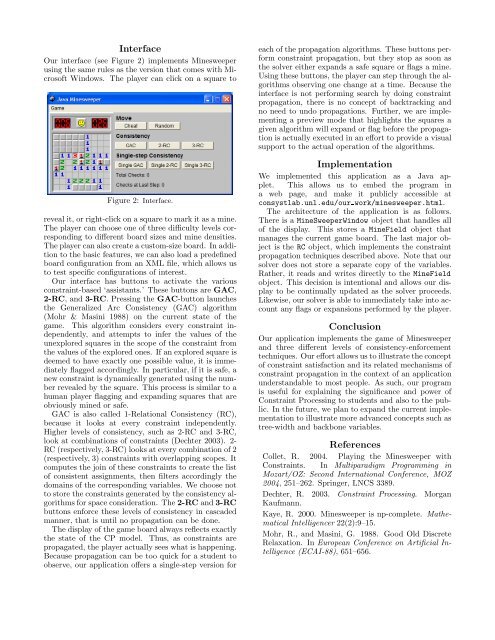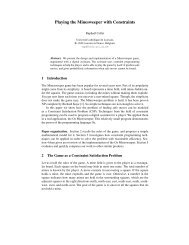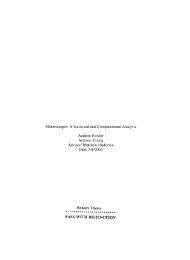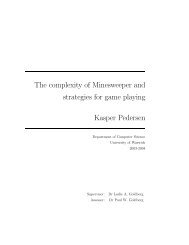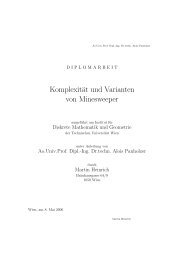An Interactive Constraint-Based Approach to Minesweeper
An Interactive Constraint-Based Approach to Minesweeper
An Interactive Constraint-Based Approach to Minesweeper
Create successful ePaper yourself
Turn your PDF publications into a flip-book with our unique Google optimized e-Paper software.
InterfaceOur interface (see Figure 2) implements <strong>Minesweeper</strong>using the same rules as the version that comes with MicrosoftWindows. The player can click on a square <strong>to</strong>Figure 2: Interface.reveal it, or right-click on a square <strong>to</strong> mark it as a mine.The player can choose one of three difficulty levels corresponding<strong>to</strong> different board sizes and mine densities.The player can also create a cus<strong>to</strong>m-size board. In addition<strong>to</strong> the basic features, we can also load a predefinedboard configuration from an XML file, which allows us<strong>to</strong> test specific configurations of interest.Our interface has but<strong>to</strong>ns <strong>to</strong> activate the variousconstraint-based ‘assistants.’ These but<strong>to</strong>ns are GAC,2-RC, and 3-RC. Pressing the GAC-but<strong>to</strong>n launchesthe Generalized Arc Consistency (GAC) algorithm(Mohr & Masini 1988) on the current state of thegame. This algorithm considers every constraint independently,and attempts <strong>to</strong> infer the values of theunexplored squares in the scope of the constraint fromthe values of the explored ones. If an explored square isdeemed <strong>to</strong> have exactly one possible value, it is immediatelyflagged accordingly. In particular, if it is safe, anew constraint is dynamically generated using the numberrevealed by the square. This process is similar <strong>to</strong> ahuman player flagging and expanding squares that areobviously mined or safe.GAC is also called 1-Relational Consistency (RC),because it looks at every constraint independently.Higher levels of consistency, such as 2-RC and 3-RC,look at combinations of constraints (Dechter 2003). 2-RC (respectively, 3-RC) looks at every combination of 2(respectively, 3) constraints with overlapping scopes. Itcomputes the join of these constraints <strong>to</strong> create the lis<strong>to</strong>f consistent assignments, then filters accordingly thedomains of the corresponding variables. We choose not<strong>to</strong> s<strong>to</strong>re the constraints generated by the consistency algorithmsfor space consideration. The 2-RC and 3-RCbut<strong>to</strong>ns enforce these levels of consistency in cascadedmanner, that is until no propagation can be done.The display of the game board always reflects exactlythe state of the CP model. Thus, as constraints arepropagated, the player actually sees what is happening.Because propagation can be <strong>to</strong>o quick for a student <strong>to</strong>observe, our application offers a single-step version foreach of the propagation algorithms. These but<strong>to</strong>ns performconstraint propagation, but they s<strong>to</strong>p as soon asthe solver either expands a safe square or flags a mine.Using these but<strong>to</strong>ns, the player can step through the algorithmsobserving one change at a time. Because theinterface is not performing search by doing constraintpropagation, there is no concept of backtracking andno need <strong>to</strong> undo propagations. Further, we are implementinga preview mode that highlights the squares agiven algorithm will expand or flag before the propagationis actually executed in an effort <strong>to</strong> provide a visualsupport <strong>to</strong> the actual operation of the algorithms.ImplementationWe implemented this application as a Java applet.This allows us <strong>to</strong> embed the program ina web page, and make it publicly accessible atconsystlab.unl.edu/our work/minesweeper.html.The architecture of the application is as follows.There is a MineSweeperWindow object that handles allof the display. This s<strong>to</strong>res a MineField object thatmanages the current game board. The last major objectis the RC object, which implements the constraintpropagation techniques described above. Note that oursolver does not s<strong>to</strong>re a separate copy of the variables.Rather, it reads and writes directly <strong>to</strong> the MineFieldobject. This decision is intentional and allows our display<strong>to</strong> be continually updated as the solver proceeds.Likewise, our solver is able <strong>to</strong> immediately take in<strong>to</strong> accountany flags or expansions performed by the player.ConclusionOur application implements the game of <strong>Minesweeper</strong>and three different levels of consistency-enforcementtechniques. Our effort allows us <strong>to</strong> illustrate the concep<strong>to</strong>f constraint satisfaction and its related mechanisms ofconstraint propagation in the context of an applicationunderstandable <strong>to</strong> most people. As such, our programis useful for explaining the significance and power of<strong>Constraint</strong> Processing <strong>to</strong> students and also <strong>to</strong> the public.In the future, we plan <strong>to</strong> expand the current implementation<strong>to</strong> illustrate more advanced concepts such astree-width and backbone variables.ReferencesCollet, R. 2004. Playing the <strong>Minesweeper</strong> with<strong>Constraint</strong>s. In Multiparadigm Programming inMozart/OZ: Second International Conference, MOZ2004, 251–262. Springer, LNCS 3389.Dechter, R. 2003. <strong>Constraint</strong> Processing. MorganKaufmann.Kaye, R. 2000. <strong>Minesweeper</strong> is np-complete. MathematicalIntelligencer 22(2):9–15.Mohr, R., and Masini, G. 1988. Good Old DiscreteRelaxation. In European Conference on Artificial Intelligence(ECAI-88), 651–656.


